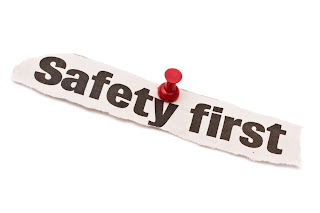MAKE-IT-SAFE MONDAY
For thousands of years humans have created clothing to
protect our bodies from harsh environments. Over the years we have
continued to evolve by creating more effective wearable shelter. To this day we
are still using science to push the boundaries in wearable safety. Today on
Make-It-Safe Monday we are going to cover some safety items that will help you
keep your body and appendages safe and increase your productivity.
One of the most common safety accessories is the steel toed
shoe. Steel toed boots were invented by the Germans near the end of World War
II. These boots have evolved and are no longer made only of steel, but can be
reinforced by composite materials, aluminum or even plastic. The solid
reinforcement in the shoe provides crush protection from falling objects and
puncture resistance if a nail or sharp object is stepped on. Manufacturers now
offer a wide variety of choices from cold weather boots to formal dress shoes
that will be perfect for any situation.
High visibility clothing is a must for any industry that
puts large machinery and workers in the same area. Bright fluorescent yellow
and orange are the two most common colors for high visibility clothing. There
are very few natural colors that mimic fluorescent yellow and orange which
allows for a stark contrast between an individual and their surroundings.
Reflective material applied to clothing is extremely important at night or in low
light conditions. This allows someone with headlights or a spotlight to
identify the contours of the human body. Reflective vests can be purchased
relatively cheap that fit over existing clothes.
Your hands are one of the most important features for
interacting with and manipulating your environment. Glove companies sell many
different sizes and types of hand protection for a wide range of applications. Puncture
proof gloves can be a lifesaver for someone that works with thin sheets of
aluminum or steel such as a home siding installer or law enforcement officer
searching a suspected drug user. Gloves with knuckle protection can save a mechanic’s
knuckles from deep cuts or broken bones when a wrench slips. Rubber insulated
gloves will prevent electrocution for workers near electricity. It is important
to find the right glove for the job and to find a pair that fits.
Be sure to account for seasonal changes in clothing. Employees
working outdoors in cold climates should always dress in layers and remove
excessive layers as needed. Exposed skin
can be susceptible to frostbite in a matter of minutes wintry weather. Advances
in nanotechnology have created coatings that can be applied to fabric to
deflect moisture and act as bug repellent. This is beneficial to keep clothes
dry and prevent hypothermia. Bug repellent coatings will keep away mosquitoes
that can carry diseases like Malaria and West Nile Virus. If an employee is
working in hot areas it is best to have light colored fabric to reflect the
sun's heat. Make sure that the clothing material is thin and breathable to
dissipate body heat.
These are just a few examples of clothing options that can
reduce work related injuries. The most important part of safety gear is making sure
that it gets worn. If a logging company provides chain saw gloves to their
employees but the workers leaves them in their truck it was a wasted effort.
The tools we have to keep us safe are only as good as the safety plan meant to
enforce their use.
Thank you for your time and attention. Let’s make it safe
this Monday
Brad Lindemann
Sales Coordinator, Lift’n Buddy, a Southworth Company





